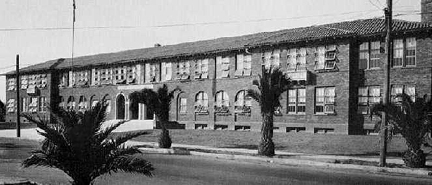

The earthquake (a magnitude 6.4) struck at 5:45 PM on March 10, 1933. I had been attending Franklin Junior High School
for a few weeks and most of the schools were substantially damaged, if not completely destroyed.
Hundreds, if not thousands of children would have been injured and killed had it occurred during
school hours.
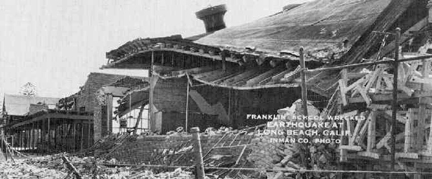

Our neighbor lady and friend was expecting and lost her baby that night when she was scalded by hot
soup spilling from the stove. The walls had fallen away from the apartment next door and left the
furniture standing around the edges. It was dusk and getting cold and we were in front of the house
and watched a man come out of the apartment carrying blankets. As the door swung closed behind him he
was crushed by falling ruble.

It seemed that every other home was setting about two feet to the right or left of their foundations.
Gas and water lines were ruptured but fortunately our home stayed in place. Many business streets were
blocked with ruble from the front of buildings.

I slept in our car that night thoroughly scared by the consistent aftershocks when the car would sway
it a little. The next day Dad drove us to Aunt Irene’s and Uncle Henry’s in San Bernardino and he and
Howard returned home and camped out in the back yard. When the utilities were turned back on he
brought us home.

We had stayed with Irene and Henry when we first arrived in California. Dad had driven on to Long Beach,
found a job and a home, and then came back for us.

I don’t remember Aunt Irene’s branch of the family but I remember her and Uncle Henry’s warmth and
generosity. Henry was a farmer and a skilled carpenter and had built a sizable and attractive home on
homesteaded land near the entrance to the Cajon Pass at the foot of the San Bernardino Mountains. The
wind had rolled a large galvanized metal water tank across the country to their home so Henry dug a
depression in the ground, rolled it in and then put the dirt back to bring the floor to the ground
level. It made a great garage with room for their car as well as other items. They had a truck garden
loaded with water melons and I discovered that peanuts grew in the ground. We could pull up all we
wanted and I learned to like them raw.
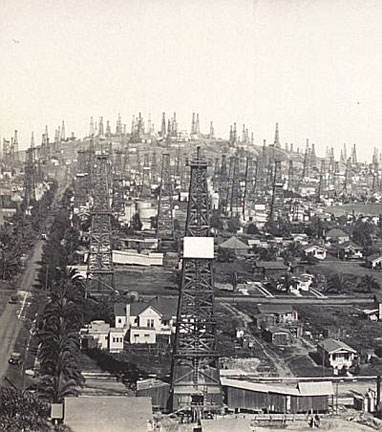

When we returned to school we met on numbered, chalked areas on the play grounds. Our books, rescued
from our lockers, were returned to us and we were given home work assignments. That continued until
tents had been erected on wooden plat forms that were later replaced with bungalows. I was in the 9A
when we occupied the first of the new buildings. School was half day for three years and grades 7
through 8B went to school in the afternoon and 8A through the 9th in the mornings. It was a big event
in our lives when we moved up to 8A and were able to spend afternoons at the beach or the lagoon and
other fun activities. Like hiking up Signal Hill with our bikes and then coasting to the bottom at
break neck speeds.

The extensive, area wide quake damage ended the depression for us. From then on Dad never lost a
day’s work and started contracting instead of working by the hour. Because of his reputation for
his painting and paper hanging skills he was the first to be called by decorators, architects and
builders as far away as Hollywood for high end decorating and imported wall papers.

About a block away a man was collecting loads of brick from the destroyed buildings and he would
pay 10 cents for every 20 bricks we cleaned of the old mortar. So, if we wanted to go to the
Saturday movie matinee and get a popsickle and a candy bar we would clean 40 bricks. We also
discovered that some had mortar that would fall off easily and others where it stuck like glue
so we always looked for the easy ones.

As another money maker Howard and I would go down the alleys and streets with our wagon searching
abandoned homes and stores for items we could take to the junk man. The junk man lived close by, had
a peg leg and conducted business out of his back yard. Once he took the cork out of whisky bottle
that had some dregs in it, smelled, and then drank it. It both surprised and shocked me.

Howard loved to fish and it didn’t matter whether it was surf, deep sea, lake, or rain or shine and
he was very good at it. He could fish with a group and the others might not catch much of anything
but he always made out. Once we went out over night without warm clothing on an old ship anchored
off shore that was used as a fishing barge. The ocean was beautiful because it was one of those times
when the water was iridescent. However, I thought daylight and the boat to take us home would never
come. I don’t remember catching any fish but I may have caught a cold.

I would tag along with Howard whenever possible, particularly when he was going to the old Pine Avenue
pier. (A storm washed it out after the Rainbow Pier was built.) Sometimes I would fish from the old
pier with a snag line but what I really loved was wandering the old Pike. I would listen to all the
pitches made by the hucksters and sometimes I stop at the "Spit and Argue Club" on the pier and listen
to the stories they would tell. I don’t know why but they fascinated me.

The Pike amusement park had been officially opened on July 4, 1902. It was known as the "Walk of a
Thousand Lights" and became one of the most popular amusement parks on the west coast. After World
War II, it was expanded and renamed Nu-Pike and closed in 1979 when the redevelopment began.
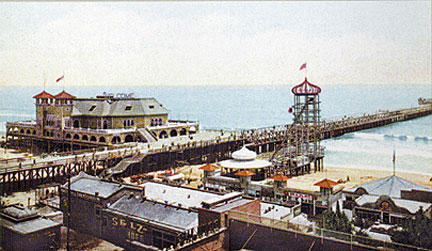

Shown here are the old auditorium, the Pine Avenue Pier and part of the Pike. The auditorium burned
in the early 1930's and the pier we fished on was washed out in a storm shortly after the
Rainbow Pier was built.
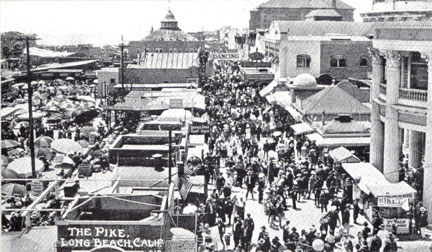

The photo at right is dated 1940, and the columns on the right are on the front of the Bath House.
All buildings on the left were built on the beach that constantly grew larger from new sand deposits.
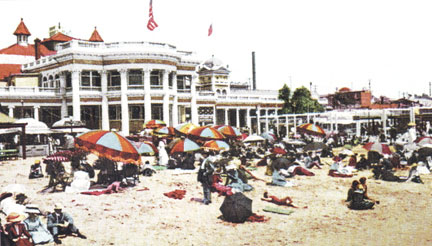

The large columned building on the left is the Bath House, nick named the "Plunge" built in 1902.

I remodeled it in 1954 and it was finally closed in the seventies. Too many people had back yard pools.

The beach area in the photo below constantly expanded and was eventually covered with more attractions.

I rarely had even a nickel for an ice cream cone or a dime for one of the rides. Favorites were the
Fun House and Looff’s beautiful merry-go-round. He also owned many of the other attractions and his
world famous Carousel horses now sell for thousands of dollars.
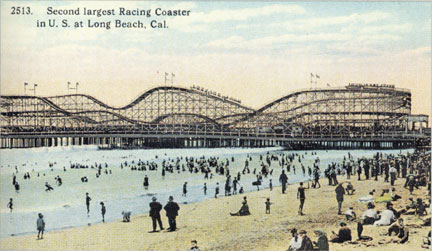

I can remember walking under and in between the pilings of the roller coaster but over the years
more sand kept expanding the beach and more attractions were built upon it. For ten cents I saw a
lot of westerns in the Rialto theatre to the right of the Plunge. Behind the Plunge was a bath
house with individual compartments for changing clothes. Dad would take us to the Plunge but
not often enough.
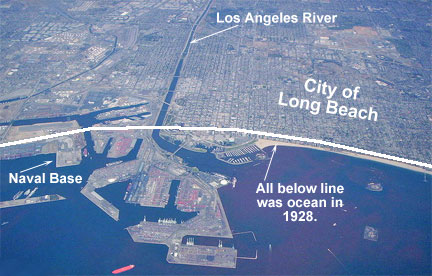

This map illustrates the changes in the ocean front since we arrived in 1928.

The Naval Base was built on Brighten Beach were we had beach parties and I had worked on the
construction of the base until I enlisted in the Air Corps.

With the exception of the Naval Base it was all built from Long Beach’s share of the gas and oil
revenues generated by the multitude of tide land oil wells. They never drilled a dry hole and
the extract-ion later caused serious subsidence that was halted by the injection of water.
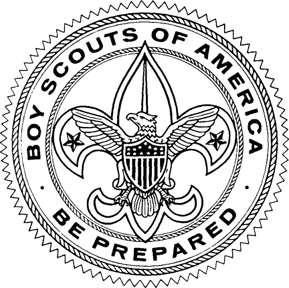

I joined Scout Troop 47 housed in the Grace Methodist Church on the corner of Third and Junipero
just a block from Bixby Park. After Scout Meeting we would go to the Park and play Capture the Flag.
Most of us were part of our neighborhood group composed of Bob Bigelow, Laurence Kaylor, Jimmy
Woods, Darrel Ransom and Marten Albright. We did a lot of things together and hung out when there
was nothing special. I earned a "Star" merit badge rank and was half way to "Eagle."

I am ashamed to say I can remember some of our activities that weren’t very scout like. For example,
Darrel somehow was able to get gun powder which we wrapped tightly in newspaper and put it on the
Toonyville Trolley track that looped down 7th St. and Broadway. When the car rolled over it, it would
exploded with a loud boom and shake the Trolley. The tranquil riders did not remain tranquil. On
Halloween we would watch until some one was getting into their car and we would stick a potato in car
exhaust so it wouldn’t start. When we had our fun we pulled the potato out and left them wondering what
their problem was. Shame on us! However, Dad told about the time they took a wagon apart and put it
together on the roof of a barn so I felt better.

In the sixties a large subdivision called Rossmoor was built on the site of Bryant Acres located just
outside of Long Beach on the south side of the San Gabriel River. I resold many of the homes years
later. At the time it was mostly scrub trees, a few cows and the Boy Scouts were allowed to camp there.
So whenever we could arranged it that’s where we were. It was close enough we could ride our bikes
or even walk if a parent wasn’t available to drive us.
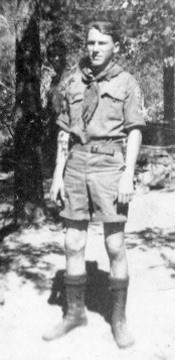

Our Scout Troop was lucky enough to go to Camp Taquits, the scout camp in Idyllwild, California. We
were lucky, because it was difficult to get a parent who could afford to take the time off during the
depression. I went again two years later as Jr. Assistant Scout Master and was both the surrogate
parent and Scout Master because there was no one else to go with them. The last night we were there
I was inducted into the honorary "Tribe of Taquits" and given the name, "Shouting Buffalo" because
of hollering at the kids. One of them was Ross, Bob Bigelow’s little brother. When we were hiking up
the switch back to the top of San Jacinto his back pack proved to be a little too heavy for him so I
carried it with mine. Ross went on to be commissioned in the Navy, came home and became an attorney,
a judge and married one of my sales ladies. He never forgot I had carried his pack.
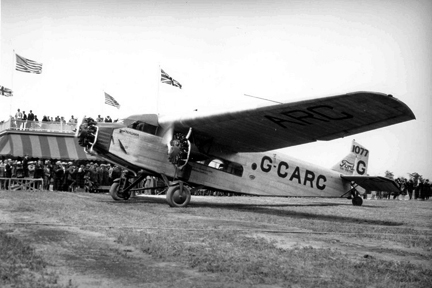

Dad took us out to see a barn storming air show at what is now the Long Beach Airport. Then it was a
several hundred acre field that belonged to the water department. The show really turned me on because
they stood on the wings, jumped with a smoke bomb and with a parachute that didn’t open until the last
minute and other stunts. I remember the Ford Tri Motor because it flew upside down and very low and
plucked up a flag on the end of a pole. The plane became a Classic and some may still fly. These memories
were a big influence on my decision to join the Air Force when the war came. It’s also the reason I
joined the Oceanside Airport Association in our successful fight to keep our airport open and expand it
to its full potential.

My best friend was Bob Bigelow and we hung out at his house a lot. Years later their home was razed
and replaced with a strip mall. There was a small storage shack behind the house where we would play
poker and smoke. When I ran for the Senate my campaign headquarters was on the site where we had
hung out as kids.

Most stores would sell cigarettes to kids if you said your Dad had sent you. There was a brand
called "Wings" that came ten to a box for ten cents. But, they were twice as long and when cut
in half you had twenty. All other brands cost at least a nickel more. I began smoking at that time
and quit when I was 40 for the same reason that I started, to prove I was a man. I had been a heavy
smoker and now I know that quitting when I did contributed considerably to my quality of life and
my pocket book.

Bob became a plumber and served in the Navy on submarine spotting dirigibles off South America. After
the war I remodeled his home and he helped me with my plumbing when I remodeled ours. Later, I sold his
home and they bought a condo on the Beach. I last saw him at our 50th High School reunion and later
learned that he had died. Larry Kaylor became a dentist and after the war, my dentist. He died early
from insulin shock. I lost track of the others.

When I graduated from Junior High I went to Poly Hi because we lived in that district while my friends
went to Wilson High. Most of the classes were still in bungalows because some of the buildings hadn’t
been rebuilt but we were going full time. I tried out for the football team but I was 140 lbs, six feet
one inch tall, had no ability and was out matched in weight and talent.

I missed my friends from Jr. High and Scouts so when we bought a home located across the high school
dividing line I transferred to Wilson High as a Junior and went out for crew. But, between the crew
workout at 11 and lunch at 12, I was physically and mentally out of it for my Physics class at 1:00 PM.
I earned my first "D" plus a few demerits for skipping the class.

When my senior year started the Principle called me in for a little heart to heart and suggested that
if I chose to graduate I should change my style. The message reached me and I cleaned up my grades and
earned extra merits. While writing this I realized I had failed to thank him when I graduated.

When I was seventeen I had an argument with Dad, I have no idea of what it was about, and moved out
and into a dollar a day room in a home that included a paper bag lunch. To offset living expenses I
dropped out of school and went to work full time for Western Union on the late shift averaging about
$1.40 a day plus very little in tips. It also had to maintain my bike. I found a greasy spoon restaurant
where I could get a bowl of chili and beans for ten cents and all the crackers I could eat. After a
couple of months I returned from a delivery one night and found my folks car parked by the bike rack
outside the office. Dad asked me to come home and return to school. His timing was great and I still
get a lump in my throat when I think about it.
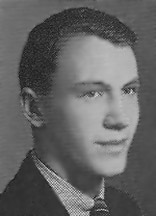
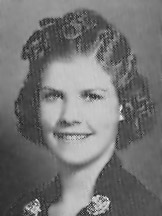

I was in Glee Club at Wilson as I had been in Junior High. The earth quake repairs had just been
completed on the auditorium and we staged the first show in six years to celebrate. It involved both
glee clubs and I met Marguerite Halicus on stage. Our first date was the Crew Team beach party but
she already had a date for our graduation dance so I went with someone I no longer remember.


There were 475 in our graduating class and we booked the Big White Steamer out of Long Beach to
take us to Catalina for the day. Kay Keiser and his band with Ishkabibble and Jenny Simms played a
matinee dance for us at the Casino and of course, Ishkabibble sang one of top tunes at the time,
"Three Little Fiddies". We steamed back to Long Beach that night. How could you have a better
Ditch Day?

From then on Marguerite and I were steadies and became engaged a year later. Her Mother pleaded
that we not marry until Marguerite graduated from Community College. A year later we were married
on October 22, 1941, just before Pearl Harbor.
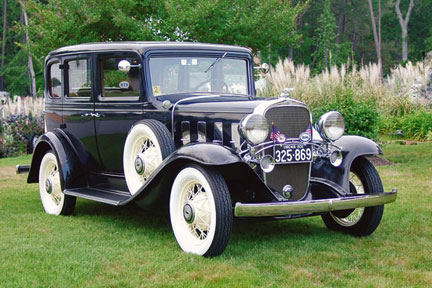

My first car. I bought Marguerite’s 1932 Chevy when we became engaged except it didn’t have white
side walls as pictured and the tires in the fender wells had chrome bands around them. It also
needed a ring job and a neighbor who was a mechanic overhauled it in our garage.

In my senior year drafting class I had made a complete set of working drawings for a home and I
knew I wanted to be an architect. When I graduated I purchased an Architectural Engineering
correspondence course for $100 paying it off at $10 a month. With my drafting instruments and a
drafting table I built in wood shop I set it up on our front porch which had been enclose with windows.
The course required reproducing a lot of drawings as well as a lot of math. Later, the Army gave me
credit for it towards my equivalence of two years of college.

After working for Dad for a year I enrolled in the Carpentry course at Frank Wiggins Trade School
in Los Angeles. Dad couldn't understand why I wanted to be a carpenter when I already had a trade
that paid as well. But, I wanted to be an Architect and I felt that it would be a step towards that
end. The teacher was the world’s best, both in his trade knowledge and teaching skills. In the class
room we learned: how to sharpen and care for our tools; how to read blueprints which I had learned
in high school; how to compute and make intricate saw cuts; the component parts of a building; how
they were assembled and how to estimate the amount of lumber, concrete, roofing, etc. Finally, we
boarded a school bus each day that took us out to Fairfax High School in Hollywood where we constructed
a Social Hall from the ground up. To make the busing time worthwhile I obtained a chauffeur's license
and was paid for driving the school bus from the school to the job and back again.


To pay expenses I had obtained a job as a riveter at Lockheed in the old Ford plant in Los Angeles.
We fabricated the ailerons for the new P-38, an advanced fighter configuration at that time. I worked
the graveyard starting at 12 until 7 AM but was paid for 8 hours.

At 3:30 I’d load the bus, head back to the school, deposit the students and take the bus to it’s parking
site. Then I would grab some sleep. I couldn’t find a room for a dollar a day that wasn’t on a noisy
street car track but you get use to it fast if you are tired enough. Of course I headed for home on
weekends.




